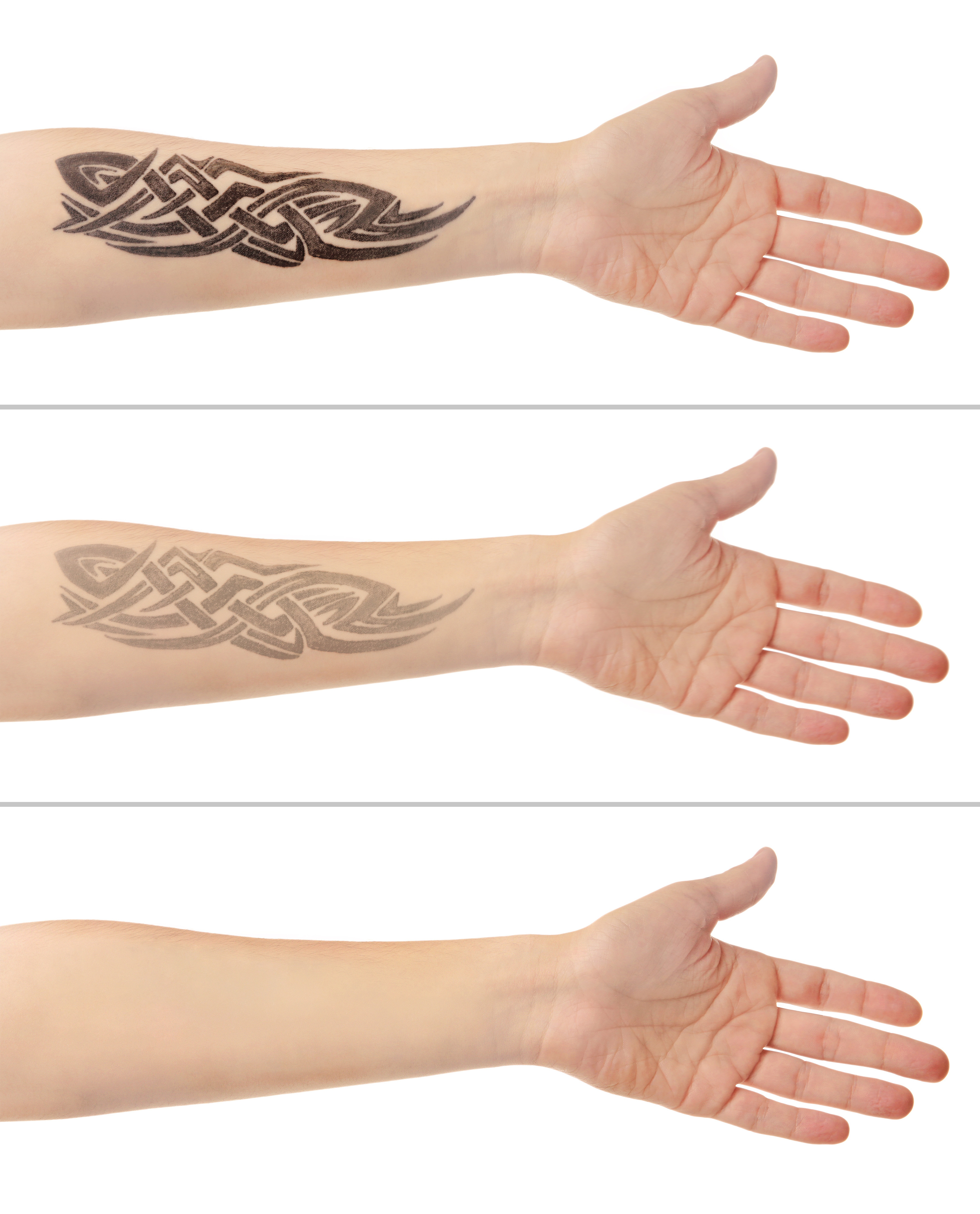
NEW! – LASER TATTOO REMOVAL
PRICING INFORMATION
BEFORE & AFTER PICTURES




LASER TATTOO REMOVAL FAQ
When you get a tattoo, the ink pigments are deposited into the dermis of the skin. Normally, the human immune system responds to foreign particles by capturing and filtering these particles out of the body. However, a tattoo is permanent because the ink particles are very large – too large for the body’s defense system to re-absorb and remove. Laser tattoo removal uses a concentrated beam of light that is selectively absorbed by the pigment of the tattoo. The laser breaks the large “boulder sized” ink particles into small “pebble sized” ink particles that the body’s immune system is then able to absorb and filter out. Each tattoo removal session removes one layer of ink. We combine the laser tattoo removal with the FracTat method to improve results. More information on the FracTat method of tattoo removal is available in the following FAQ section.
The FracTat procedure is a pre-treatment to the laser tattoo removal. Considered to be a “priming”, this procedure creates micro-sized holes in the skin over the tattoo. This allows for the gases and ink particles to easily escape through the skin thus avoiding blistering, scaring, and skin damage. Excitingly, this allows for you to do up to three tattoo removal passes in one sitting resulting in faster tattoo removal while keeping your skin safe.
Step one: We start by using the FracTat hand-piece to go over your tattoo and “drill” micro sized holes on top of your tattoo.
Step two: We then pass over the tattoo with the q-switch laser. We may do additional passes with the q-switch laser.
Step three: Finally, we apply post care and your laser tech will further explain home-care instructions. We will develop a plan for your treatments and discuss with you when to come back for your next session.
Laser tattoo removal is not pain free. The sensation may vary greatly depending on your natural pain tolerance. If you found that the tattoo application was fairly painless, then you may find tattoo removal quite tolerable also. That being said, your laser tech will be using a cooling method called cryo that blows cool air to help minimize the discomfort. This is applied before, during and after the lasering.
Successful tattoo removal is dependent on several factors:
1) Age of the tattoo – Older tattoos have typically faded naturally over time. These are often the easiest to remove.
2) Location of the tattoo – Location affects removal in areas that have less blood supply (ie hands, feet, ankles) compared to areas with better blood supply (ie back, arms, stomach). Healing times are longer in areas of low blood circulation.
3) Whether or not the tattoo was applied professionally – If your tattoo was done professionally then most likely the artist used a very concentrated ink which deposits heavily into the skin.
4) Skin colour – Typically, Fitzpatrick skin types 1-2 experience the most success with tattoo removal as less laser energy is absorbed by the skin and is instead directly focused into the tattoo. In comparison, with darker skin types, a fraction of the laser energy is absorbed by the skin. Also, with darker skin types, the settings may need to be lowered for safety reasons meaning that more sessions would be required to achieve the desired results.
5) Previous scaring or tissue damage – Scarred or damaged tissues often have a harder surface which is more challenging for the laser energy to penetrate.
6) Layered tattoos or cover-ups – These types of tattoos often have more than one layer of tattoo pigment or more than one colour of pigment deposited into the skin. This results in a larger density of ink and an increase in the overall volume of ink to be removed.
Because of the above mentioned factors, anywhere from 3-12 visits may be required.
To prepare for treatment please cleanse and shave the entire tattooed area.
Each removal session will be spaced approximately 8 weeks apart.
Scarring and pigment changes of the skin are possible side effects of laser tattoo removal, however, because we are using the FracTat method, scaring is of minimal risk.
Immediately after treatment you can expect to feel some tingling and warmth. Swelling is typically present. You may notice blistering in areas that are heavily inked. Because we will be using a FracTat method, you may also experience some pin point bleeding. This is a good thing! We will be applying some Polysporin and bandages before we let you go. Week one post treatment: Swelling will remain for several days. Common side effects are weeping, pin point bleeding, swelling, and warmth in the treatment area. Week two post treatment: Common side effects include dry, itchy skin. It’s healing!
Home care is very important and very simple. Immediately after the treatment, ice the area as much as possible. Cleanse the area once per day. Apply Polysporin as needed and bandage as needed for up to 1 week post treatment. Further instructions and post care info will be given after your first treatment.
No heavy sun exposure is permitted for one month before treatment and for two weeks post treatment. Sun exposure increases the risk of pigmentation changes of the skin. We understand that sun exposure from general day to day activities is unavoidable. That being said, please make efforts to apply sunscreen, stay in the shade, and/or cover the desired treatment area with clothing.
Side effects are unique to each individual. Listed below are the most common and how to cope with each:
1. PIN POINT BLEEDING
We used an application that puts holes in your skin so pin point bleeding should be expected. This is a good thing! These little holes are going to allow what a traditional tattoo removal laser can’t do. The holes allow gas to escape from the skin, meaning less chance of blistering and minimized risk of damage to the skin. This means that we can often do more than one pass to the tattoo area – meaning better results. It also helps with the healing time and quickens the removal process.
2. SWELLING
You will experience this immediately after the removal session. It will be localized to the area of the tattoo removal.
Keep swelling under control by placing ice packs on the area. Do this right after the procedure and every few hours after that to keep swelling at bay. This can last a full day or so.
3. FROSTING
Like swelling, you will experience this immediately after the procedure. It’s presence post-procedure is a good thing. It means the laser has interacted with the ink in the skin. When the laser targets the pigmented section of the skin, the heat produces a chemical reaction with the ink. The high temperature brings about the formation of gas or plasma, which is then released into the more superficial layers of the skin. In these layers, the gas or plasma become carbon dioxide. Carbon dioxide interacts with the tattoo and the tattoo puffs up and turns white. This can last up to 30 mins after the session. Using the FracTat allows these gases (as well as some ink) to escape the skin through the pre-formed holes. Frosting is most prevalent in the beginning stages of removal the further down the road, less frosting appears.
4. BLISTERING
As mentioned above, using the FracTat method will keep blistering to a minimum. In the event that blistering does occur, don’t pop them. Cover the treated area with Polysporin, bandages and keep clean. Refrain from touching the area. Wash the treated area with very mild antibacterial soap when you feel it is necessary. This phase can last up to a week. If fever or swollen lymph nodes are present contact your doctor immediately.
5. ITCHING
Many find this to be the worst phase. Don’t worry, there are solutions! The itching means your body is healing. Do not take any hot showers while you are undergoing tattoo removal, as the hot water may worsen the itching. Absolutely no scratching! A post-treatment home care kit and instructions will be given after your first session. The items in this kit should help soothe any itching.
6. SCABBING
Scabbing takes place after blister formation. It’s an indication that your body is healing. A scab forms above damaged skin that is replacing itself underneath. A scab should be healed within two weeks of a removal. Because we use the FracTat technology, scabbing should be minimal.
7. HYPERPIGMENTATION/HYPOPIGMENTATION
It is possible to notice pigment changes in your skin as you are going through tattoo removal. There are two classifications when it comes to skin discoloration: hyperpigmentation and hypopigmentation. In hyperpigmentation, you’ll notice patches of darkened skin. In hypopigmentation you’ll notice patches of lighter skin. These discoloration issues occur because of changes to the melanin (pigment) in the skin. This is a cosmetic side effect that can usually be covered up with makeup. The effects are not normally permanent and the skin coloration will often return to normal over time. In some cases, the pigmentation changes are permanent.
